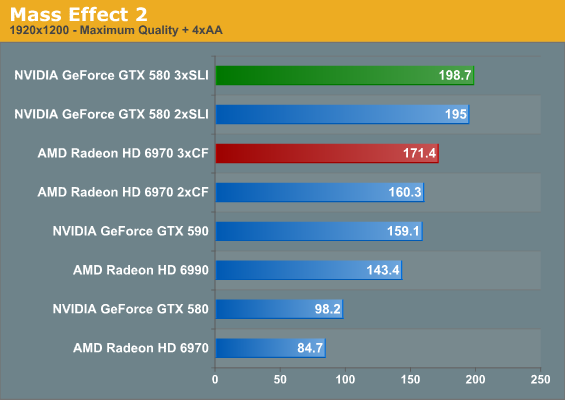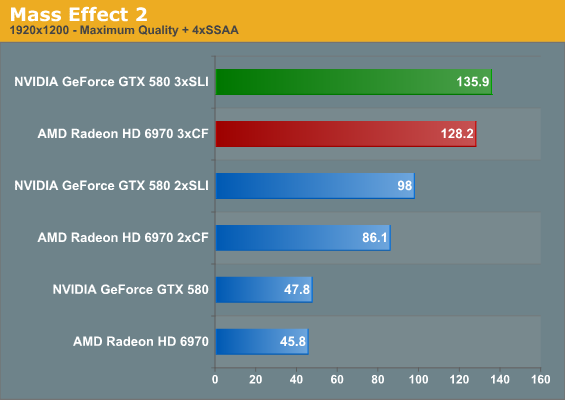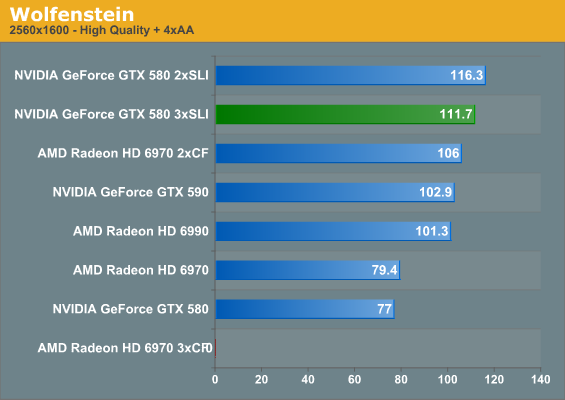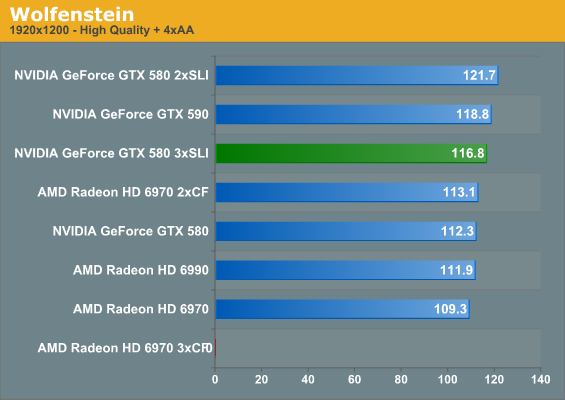A Look At Triple-GPU Performance And Multi-GPU Scaling, Part 1
by Ryan Smith on April 3, 2011 7:00 AM ESTMass Effect 2, Wolfenstein, and Civ V Compute


Mass Effect 2 is a game we figured would be GPU limited by three GPUs, so it’s quite surprising that it’s not. It does look like there’s a limit at around 200fps, but we can’t hit that at 2560 even with three GPUs. You can be quite confident with two or more GPUs however that your framerates will be nothing short of amazing.

For that reason, and because ME2 is a DX9-only game, we also gave it a shot with SSAA on both the AMD and NVIDIA setups at 1920. Surprisingly it’s almost fluid in this test even with one GPU. Move to two GPUs and we’re looking at 86fps – again this is with 4x super sampling going on. I don’t think we’re too far off from being able to super sample a number of games (at least the console ports) with this kind of performance.


Wolfenstein is quite CPU limited even with two GPUs, so we didn’t expect much with three GPUs. In fact the surprising bit wasn’t the performance, it was the fact that AMD’s drivers completely blew a gasket with this game. It runs fine with two GPUs, but with three GPUs it will crash almost immediately after launching it. Short of a BSOD, this is the worst possible failure mode for an AMD setup, as AMD does not provide individual game settings for CF, unlike NVIDIA who allows for the enabling/disabling of SLI on a game-specific basis. As a result the only way to play Wolfenstein if you had a triple-GPU setup is to change CrossFire modes globally, which requires a hardware reconfiguration that takes several seconds and a couple of blank screens.
We only have one OpenGL game in our suite so we can’t isolate this as an AMD OpenGL issue or solely an issue with Wolfenstein. It’s disappointing to see AMD have this problem though.

We don’t normally look at multi-GPU numbers with our Civilization V compute test, but in this case we had the data so we wanted to throw it out there as an example of where SLI/CF and the concept of alternate frame rendering just doesn’t contribute much to a game. Texture decompression needs to happen on each card, so it can’t be divided up as rendering can. As a result additional GPUs reduce NVIDIA’s score, while two GPUs does end up helping AMD some only for a 3rd GPU to bring scores crashing down. None of this scores are worth worrying about – it’s still more than fast enough for the leader scenes the textures are for, but it’s a nice theoretical example.
| Radeon HD 6970 | GeForce GTX 580 | |||||
| GPUs | 1->2 | 2->3 | 1->3 | 1->2 | 2->3 | 1->3 |
| Mass Effect 2 | 180% | 142% | 158% | 195% | 139% | 272% |
| Mass Effect 2 SSAA | 187% | 148% | 280% | 198% | 138% | 284% |
| Wolfenstein | 133% | 0% | 0% | 151% | 96% | 145% |
Since Wolfenstein is so CPU limited, the scaling story out of these games is really about Mass Effect 2. Again dual-GPU scaling is really good, both with MSAA and SSAA; NVIDIA in particular achieves almost perfect scaling. What makes this all the more interesting is that with three GPUs the roles are reversed, scaling is still strong but now it’s AMD achieving almost perfect scaling on Mass Effect 2 with SSAA, which is quite a feat given the uneven scaling of triple-GPU configurations overall. It’s just a shame that AMD doesn’t have a SSAA mode for DX10/DX11 games; if it was anything like their DX9 SSAA mode, it could certainly sell the idea of a triple GPU setup to users looking to completely eliminate all forms of aliasing at any price.
As for Wolfenstein, with two GPUs NVIDIA has the edge, but they also had the lower framerate in the first place. Undoubtedly being CPU limited even with two GPUs, there’s not much to draw from here.










97 Comments
View All Comments
Ryan Smith - Sunday, April 3, 2011 - link
It took awhile, but we finally have 3 120Hz 1080P monitors on the way. So we'll be able to test Eyefinity, 3D Vision, and 3D Vision Surround; all of which have been neglected around here.Kaboose - Sunday, April 3, 2011 - link
I await these tests with breathless anticipation!veri745 - Sunday, April 3, 2011 - link
While this article was very well written, I think it is hardly worth it without the multi-monitor data. No-one (sane) is going to get 3x SLI/CF with a single monitor, so it's mostly irrelevant.The theoretical scaling comparison is interesting, but I'm a lot more interesting in the scaling at 3240x1920 or 5760x1080.
DanNeely - Sunday, April 3, 2011 - link
This is definitely a step in the right direction; but with other sites having 3x 1920x1200 or even 3x 2560x1600 test setups you'll still be playing catchup.RK7 - Sunday, April 3, 2011 - link
Finally! I created account just to write that comment :) That's what's missing and what definitely needs to be tested! Especially 3D Vision Surround - it's good to know if it's worth to put so much money into such setup, because single card may be on the edge of performance for modern games in stereoscopic mode with single monitor (good example is Metro 2033, that blows mind when in 3D, but I found with single GTX 570@900MHz is playable only at 1600x900 in 3D with maximum settings without DoF and AA, and even in such case it could drop for some action scenes with heavy lighting to ~12 fps...). So if three cards can achieve a good scaling and provide performance per monitor for 3 monitors setup close to single card for one monitor, then we're there and it's worth it definitely, but if numbers will be alike to those for single monitor scaling, then folks should be aware that there's no way for maximum visual quality gaming with current hardware on 3 monitors...Dustin Sklavos - Monday, April 4, 2011 - link
Not completely neglected. I've added triple-monitor surround testing to my boutique desktop reviews whenever able. :)Crazymech - Sunday, April 3, 2011 - link
I'm having my doubts about the capabilities of the 920 OC'd to 3.33 GHz matched up with 3 of the most powerful single GPUs.I understand straying away from SB because of the lanes, but you could at least have upped the OC to 3,8-4, which many people do (and I would think most that considers a tripple setup would use).
To underline it I point to the small differences between the 4.5 GHz 2600K and the lower overclocked one in the boutique builds reviews, with the highest clocked CPU coupled with weaker GPU's nipping at the heels of the more powerful GPU.
I suggest you at least experiment in a single test (say metro for example.. or battlefield) what a higher clocked X58 (or the 980's 6 cores) could do to the setup.
If I'm wrong, it would at least be good to know that.
BrightCandle - Sunday, April 3, 2011 - link
The fact that sandy Bridge has a PCI-E lanes problem is grounds for testing the impact.Still I would rather see the numbers on X58 and triple screen gaming before seeing the impact that SB makes the performance of SLI/CF setups.
Ryan Smith - Sunday, April 3, 2011 - link
For what it's worth, 3.33GHz is actually where this specific 920 tops out. It won't take 3.5GHz or higher, unfortunately.We'll ultimately upgrade our testbed to SNB - this article is the impetus for that - but that's not going to happen right away.
Crazymech - Monday, April 4, 2011 - link
It wont take 3.5? Really? That amazes me.Though very unfortunate for the purpose of this test.
The main focus is (of course) always on how the new GPU in relation to a standard CPU improves the framerate, but once in a while it would be interesting what different CPU's do to the GPU and FPS aswell. Like the old Doom III articles of showing Athlon dominating PenIV.
Thanks for the answer anyhows :).